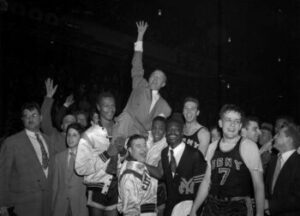Today, over 30 states have legalized online sports betting, all with college sports teams, and thousands of college-age students are allowed to bet online.
Not all states allow college betting; some have complete restrictions, while others, like Pennsylvania allow it on all NCAA events while prohibiting betting on markets directly associated with individual players, so-called player props. Still, the problem is prevalent enough for the NCAA to forbid student-athletes, coaches or athletic staff members from wagering or providing information to others that may impact the outcome of a game.
Violation of this rule used to result in a student athlete’s suspension for an entire season. Still, these days, the NCAA organization has applied more moderate punishment in the form of a sliding scale, ranging from a 10% season suspension up to permanent ineligibility, depending on the severity of the involvement.
Throughout history, several college sports betting scandals have shocked the public and helped inform lawmakers and the NCAA about the rules and regulations surrounding sports betting.

1945: The Five Brooklyn College Men’s Basketball
During a police raid on a suspected criminal’s apartment, the NYPD discovered evidence of match-fixing between Brookly Five and Akron University in college basketball. The game was to take place the following evening, and players from the Brooklyn Five had accepted $1,000 to lose the match intentionally.
Back in 1945, there were no specific rules around bribery and match-fixing. However, the incident led the state of New York to include amateur sports in the bribery laws and includes one of the earliest references to limiting the margin of victory, so-called point shaving relating to spread betting. Regarding the players, none were arrested or fined, and the game was never played.
1947-1950: The Largest College Sports Betting Scandal of the 1940s
In 1951, the largest college sports betting scandal in history unfolded, and it was discovered that 33 players from seven different colleges had been involved in point shaving in over 86 games from 1947 to 1950. The scandal involved Bradley University, the City College of New York, Columbia University, Manhattan College, New York University, Long Island University, the University of Kentucky, and the Toledo University of Ohio.
In total, 32 players were initially arrested, with the 33rd, a Columbia student, connected to the case several years later. The CCNY was moved to Division III, the LIU shut down its athletics program between 1951 and 1957, and Kentucky cancelled its 1952/53 season.
1957-1961: The Largest College Sports Betting Scandal of the 1950s and 1960s
Another large gambling ring was uncovered in 1961 when a college student had been approached to fix a basketball game and later told his coach, who informed the authorities. It involved 22 schools this time, and 37 players were eventually arrested. One of the key figures was then-pro basketball player Jack Molinas, who was sentenced to 10 to 15 years in prison.
He served five, and the incident and his involvement inspired the 1974 blockbuster movie “The Longest Yard,” starring Burt Reynolds without a mustache. The incident led to another landmark bill, with Congress criminalizing match-fixing at the federal level through the Sports Bribery Act of 1964.
1978-79: Boston College Men’s Basketball
During the 1978/79 basketball season, it was Boston College’s turn to be scandalized by a scandal involving the New York mob. Nine games were affected, and only four produced the desired outcome. The scheme wasn’t successful, and the mob gave up on it.
The scandal wasn’t uncovered until 1980 when legendary mobster Henry Hill was arrested and agreed to disclose information about the scheme in exchange for immunity. Only one player received a 12-year sentence as a result.
1994: Arizona State Men’s Basketball
Las Vegas bookmakers became varied after receiving big money on games involving Arizona State, most prominently $1 million on a game between Arizona State University and Washington University in March of 1994. The bookies informed the Pac-10, the Nevada Gaming Control Board and the FBI of the suspicious wagers.
It turned out that ASU’s point guard Stevin “Hedake” Smith had received over $80,000 to shave off points in different games during the 1993/1994 season. Smith had turned himself in, which resulted in one year in prison and the main perpetrator of the gambling ring, Benny Silman, spent four years behind bars.
Recent cases like this have often been used to argue for legalising sports betting so that legitimate sportsbook operators monitor and report all betting activity to official channels.
2011: University of San Diego Men’s Basketball
Point Guard Brandon Johnson of the University of San Diego had been convinced by former USD assistant head coach Thaddeus Brown to shave points off four matches during the 2009/10 season in return for up to $10,000 per game.
The sports betting scandal came to light after an unrelated drug-trafficking and illegal gambling investigation revealed the involvement of Brown and Johnson. Johnson was suspended and sentenced to six months in prison, while Brown spent one year in jail.
In recent years, as legalized sports betting has become accessible in the United States, colleges have scrambled to educate players, with the NCAA bombarding all participants about not engaging in sports betting. Still, there are more minor incidents of rule violations every season, but so far, there have been no wide-reaching scandals of the magnitude of those of the 1940s to 1970s.